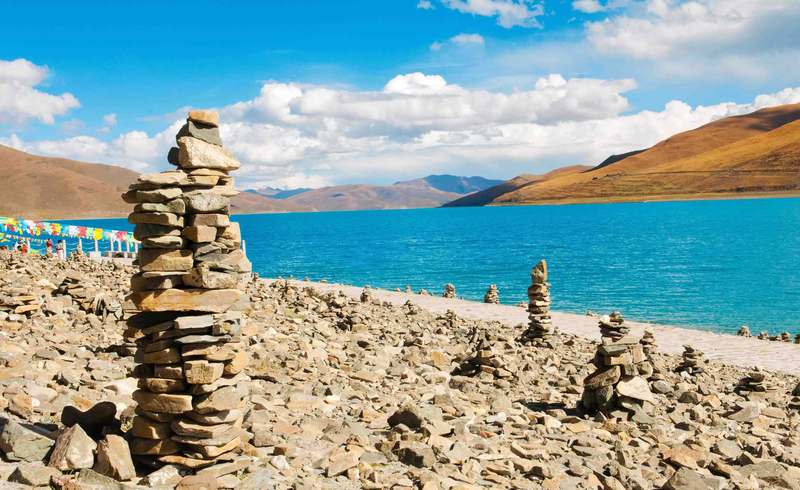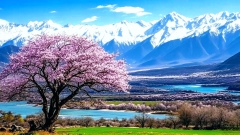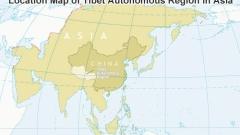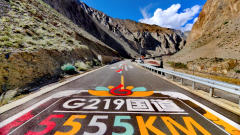High on the roof of the world, the region of Tibet occupies an extraordinary place on the map of Asia. With an average altitude exceeding 4,000 metres, the Tibetan Plateau is framed by towering mountain ranges and cradles of great rivers. The autonomous region of Tibet lies in China’s far west and south-west, yet its geographical and cultural connections extend far beyond. Tibet shares its land boundaries with several Chinese provinces and multiple neighbouring countries and regions — making it a vital gateway between Central, South and Southeast Asia.
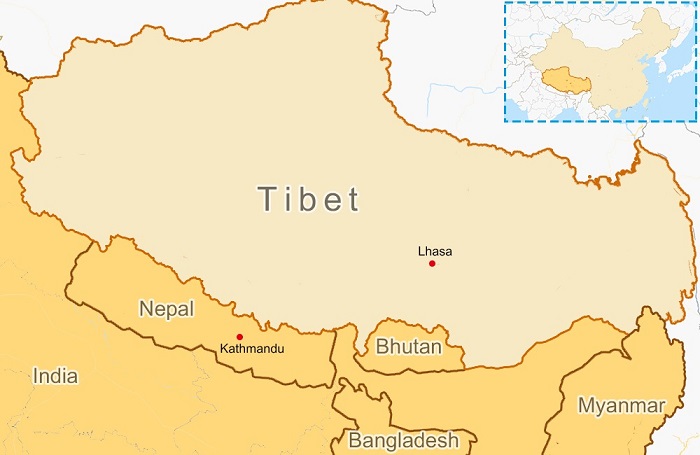
Surrounding Countries of Tibet
Internal Borders: China Provinces at Tibet’s Edge
Tibet and Xinjiang & Qinghai
On the northern flank, Tibet meets the vast region of Xinjiang Uygur Autonomous Region and borders Qinghai Province to the northeast. These high-plateau zones share a rugged terrain of alpine lakes, desert-edges and mountain chains. While not always on the standard tourist trail, these internal borders highlight how Tibet is more than a remote enclave — it sits at the confluence of diverse landscapes within China.
Tibet and Sichuan & Yunnan
To the east and southeast, Tibet borders Sichuan and Yunnan provinces. These regions are more accessible, and in many cases connect different ecosystems — from the forested slopes of Yunnan to the deep gorges of Sichuan and finally up to the Tibetan highlands. For travellers, routes from eastern or southern China into Tibet may pass through these provinces, offering a gradual shift in altitude, culture and scenery.
These internal borders underscore how Tibet is integrated into a broader Chinese geographic and administrative system, but also serve as entry points for travellers coming from other parts of China.

China Provinces at Tibet’s Edge
Border With Nepal: Himalayas and Overland Access
Tibet–Nepal Neighbourhood
The border between Tibet and Nepal stretches along the mighty Himalayas for approximately 1,389 kilometres. This high-altitude line runs northwest to southeast and even intersects the world’s highest mountain: Mount Everest (called Chomolungma or Qomolangma on the Tibetan side). The terrain is dramatic: glaciers, snowfields, steep valleys and sacred peaks dominate the landscape.
Key Port: Gyirong / Jilong
For international travellers wishing to cross from Nepal into Tibet, one of the most viable routes is via the Gyirong Port (also known as Jilong) in Shigatse Prefecture. Over recent years this border crossing has become the main overland gateway between Tibet and Nepal. Previously, the port at Zhangmu (between Tibet and Nepal) was widely used, but after the 2015 earthquake many parts were closed and operations shifted. For travellers, this means that an overland tour from Nepal into Tibet is more feasible than ever, if arranged properly.
Travel & Tourism Considerations
Crossing the Nepal-Tibet border offers spectacular scenery and a meaningful journey, but also demands preparation: the altitude climbs steeply, passes can be high, and weather may be unpredictable. Road conditions can be affected by landslides, snowfall or seasonal closures — for example, traffic control has been reported between Gyirong town and the port due to ongoing road works. Travellers should work with experienced transport and tour arrangements, plan sufficient altitude acclimatisation, and keep flexibility in their plans.
The Tibet-Nepal border is thus not just a line on a map, but a dynamic interface of culture, geography and adventure — one of the most exciting entry routes for an international tourist exploring Tibet and its neighbours.
Border With India: Sacred Routes, High Passes, Limited Crossings
India–Tibet Frontier
On Tibet’s southern border, India looms large — not only by size but by cultural and spiritual connections. While many of the official passes between India and Tibet are closed to regular tourist traffic, the significance of this border region is immense: for centuries pilgrimage paths, ancient trade routes and Hindu-Buddhist connections have spanned this frontier.
Three key mountain passes that once linked Tibet to India are Shipki La Pass in Himachal Pradesh, Lipulekh Pass in Uttarakhand and Nathu La Pass in Sikkim. These passes sit at altitudes between about 4,300 and 5,340 metres. However, they are currently closed to most tourists and used primarily for special pilgrimage or trade purposes.
Spiritual Connection: Mount Kailash
One of the most profound links between India and Tibet in this region is Mount Kailash, located in Purang County, Ngari Prefecture of Tibet. Revered in Hinduism (as the abode of Shiva), Buddhism, Bon and Jainism, it is a pilgrimage centre of global significance. Indian pilgrims have long travelled to Kailash and Lake Manasarovar, often via Nepal or internal Tibet routes, thus reinforcing the spiritual bridge between India and Tibet.
Practical Notes for Travellers
For international tourists from India wanting to enter Tibet, the typical route is to travel first via Nepal and then cross via Gyirong Port or other approved inland entry points in China. Direct tourist foot access via the Indian-Tibet border is rarely available due to border control and permit regulations. Understanding this route flexibility is key in planning a Tibet-India connected journey.
Border With Bhutan: Remote, Serene and Undeveloped for Tourists
Bhutan–Tibet Border
To the southeast of Tibet lies the Kingdom of Bhutan — a land of deep forests, high valleys and Buddhist traditions that parallel parts of Tibet’s own heritage. The border between Bhutan and the Tibet Autonomous Region spans about 470 kilometres but there is no fully developed official tourist pass between the two at the moment.
Travel Reality
For a traveller, the easiest way to link Bhutan and Tibet would be via Nepal (from Tibet into Nepal → Nepal into Bhutan) rather than a direct crossing. The journey is more complex, often multi-leg, and any connection between the two sides remains sensitive and less developed for tourism.
Cultural Resonance
What makes this frontier especially appealing is the shared Buddhist heritage: Bhutan’s monarchy and religious culture connect in many subtle ways to the high-plateau Buddhist and Bon traditions in Tibet. For deep cultural travellers, this border region offers silent resonance even if the direct crossing is not yet straightforward.
Border With Myanmar: A Thin Line and Remote Pathways
Myanmar & Tibet
The southwestern edge of Tibet touches the extreme northern tip of Myanmar (Burma) via a relatively small stretch of land (about 189 kilometres within the Tibetan-Myanmar border zone). The terrain is wild, remote, largely undeveloped for international crossing, and used more for regional trade or local transit rather than standard tourist routes.
Diphu Pass and its Status
One of the known but non-tourist-friendly routes is the Diphu Pass located near the tri-point where China (Tibet), India and Myanmar meet. Because of its remote location and informal status, it is currently not recognised as a border crossing for international tourists.
Meaning for Travellers
While this section of Tibet’s border is unlikely to feature in mainstream tourism itineraries, its very presence underscores how Tibet sits at the crossroads of Southeast Asia as well as South Asia. For adventure travellers or those working on truly remote overland experiences, the notion of the Tibet-Myanmar frontier can hold fascination — if used with caution and local support.
Border With Kashmir & Ladakh: Historical Gateways and Contemporary Complexities
Tibet and Kashmir / Ladakh
On Tibet’s western flank lies the complex region of Ladakh (part of the larger Kashmir region). Historically, Ladakh was very much connected to Tibet: in the 17th century it was incorporated into the Tibetan cultural-religious sphere, with strong Buddhist links (especially the Kagyu tradition). Geography-wise, Ladakh acted as a transitional zone between the high plateau of Tibet and the mountain chains of Central & South Asia.
Border Crossings Today
While in earlier centuries trade and religious pilgrimage occurred across this frontier, today there is no regular tourist border crossing between Tibet and Ladakh/Kashmir. The border is sensitive and access is restricted. Still, the historical diffusion of culture and religion across this frontier remains deeply palpable.
Implications for Travel
For the international traveller interested in the history of Himalayan Buddhism, ancient trade routes and frontier cultures, the Tibet-Ladakh axis represents a rich seam of exploration (though in practice it may mean separate visits to Ladakh and Tibet, rather than a direct crossing).
Why These Borders Matter for Travellers
Tibet’s borders are not simply administrative lines — they frame dramatic transitions in geography: from high alpine plateaus down into Himalayan valleys, from Tibetan grasslands into subtropical foothills, from Buddhist-Tibetan cultural zones into South Asian plains and Southeast Asian hills. Each border gives rise to a different flavour of travel experience.
From a practical tourism perspective, the border ports and entry routes define how you can travel. For example, the overland crossing from Nepal into Tibet via Gyirong Port offers one of the most spectacular and realistic entry routes for international tourists. Knowing which borders are open, which are closed, and what permits are needed is key to planning.
Highlight Destinations & Experiences by Border Region
Nepal–Tibet Route Adventure
Embarking from Kathmandu (Nepal) then travelling northwards through the Langtang Valley, cross into Tibet via Gyirong, soak in Tibetan-Nepali mixed border town culture, and continue into Shigatse or Lhasa. Expect glaciers, soaring peaks, Tibetan-Nepali trade towns and a dramatic elevation gain.
India–Tibet Pilgrimage Frame
For those drawn to sacred landscapes, a pilgrimage-style journey might include visiting Mount Kailash, Lake Manasarovar and the north-west frontier of Tibet. While direct crossing from India may be limited, many pilgrims route via Nepal or intra-China travel. This axis links deeply with spiritual traditions of Hinduism, Buddhism and Bon.
Bhutan-Tibet Cultural Reflection
Though not a typical direct crossing, planning visits to Bhutan (Paro, Thimphu, Bumthang) and then entering Tibet via Nepal or China’s internal road network allows a wide-spectrum Himalayan cultural experience — from Bhutan’s “Gross National Happiness” strategy to Tibet’s high-altitude monasteries.
Kashmir/Ladakh and Tibetan Cultural Landscapes
While direct border crossings may be closed, combining a visit to Ladakh (Leh, Nubra, Pangong) with a separate journey into western Tibet gives travellers an overarching Himalayan Buddhist cultural arc: from Ladakh’s monasteries and remote valleys to Tibet’s sacred peaks and plateau horizons.
Thinking Beyond the Route: Why Tibet’s Borders Enrich Travel
When you travel to Tibet, you’re not simply visiting one destination — you’re entering a region whose identity is shaped by its borderlands. These ideas matter:
- Edge experiences: The very fact you are near the edge of the plateau, near national and cultural frontiers, amplifies the sense of adventure.
- Plateau awareness: Tibet’s north-south and east-west borders remind you that while Lhasa acts as the cultural heart, the plateau extends in different directions into Xinjiang, Qinghai, Yunnan, Nepal and beyond.
- Connectivity & history: Ancient routes (tea-horse roads, pilgrimage trails, salt/tea trade) once connected Tibet with Nepal, India, Bhutan and beyond. While many of those are no longer in full use, their legacy remains in the names, monasteries and villages you’ll encounter.
- Ecological transition zones: From the high glaciers of the Himalayas down into more temperate zones the further you travel south, you’ll experience a shift in flora, fauna and human settlement patterns — something border geography makes manifest.
- Cultural layering: In border towns you may find mixed ethnic groups: Tibetans, Sherpas, Nepalis, Bhutanese, Ladakhis — offering you a rich cross-cultural experience that a destination purely within Tibet’s interior may not provide.
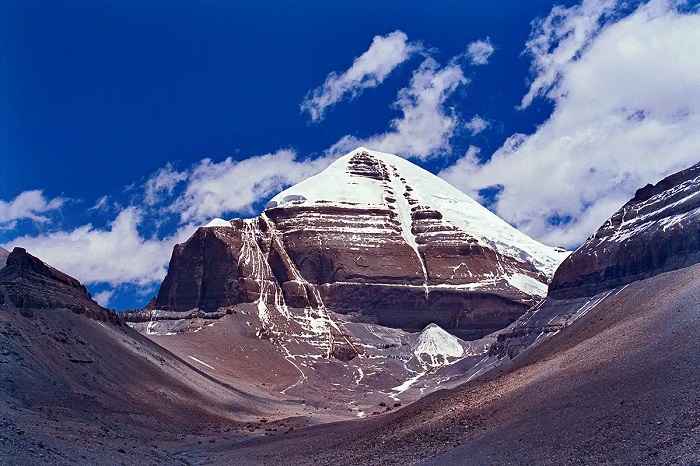
Mount Kailash
Tips for Planning a Border-Aware Tibet Trip
- Choose your border crossing route wisely: If you plan an overland tour between Nepal and Tibet, ensure you use an approved port like Gyirong, and check current road status and regulations.
- Allow extra altitude buffer: Entering Tibet from Nepal or India means faster altitude gain; build in a day of acclimatisation before heading into high-altitude zones.
- Work with an experienced local operator: Especially one who knows the border regulations, permits, road conditions and local logistics (vehicles, drivers, accommodation).
- Stay flexible: Road closure, weather or seasonal restrictions may force last-minute changes — a flexible mindset keeps the journey enjoyable.
- Respect local cultures: Border zones often host communities with distinct languages, traditions and religious practices. Keep an open heart and respectful attitude.
- Document your travel route: If entering via a less-common border, make sure your travel documents, visas and permits are in order well in advance.
- Pack for variety: Border routes may traverse high alpine passes but also lower valley zones; pack for cold nights, midday sun, and sudden weather shifts.
At China Dragon Travel, we specialise in tailor-made Tibet and neighbouring region tours. Contact us for bespoke itineraries, expert local insight and seamless logistics across the high-altitude borderlands.



